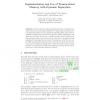Free Online Productivity Tools
i2Speak
i2Symbol
i2OCR
iTex2Img
iWeb2Print
iWeb2Shot
i2Type
iPdf2Split
iPdf2Merge
i2Bopomofo
i2Arabic
i2Style
i2Image
i2PDF
iLatex2Rtf
Sci2ools
134
click to vote
CC
2009
Springer
2009
Springer
Implementation and Use of Transactional Memory with Dynamic Separation
Abstract. We introduce the design and implementation of dynamic separation (DS) as a programming discipline for using transactional memory. Our approach is based on the programmer indicating which objects can be updated in transactions, which can be updated outside transactions, and which are read-only. We introduce explicit operations that identify transitions between these modes of access. We show how to guarantee strong semantics for programs that use these DS operations correctly, even over an STM implementation that provides only weak atomicity. We describe a run-time checking tool (analogous to a data-race detector) that can test whether or not a program is using DS operations correctly. We also examine the use of DS in an asynchronous IO library.
Asynchronous Io Library | CC 2009 | DS Operations | Programming Languages | Run-time Checking Tool |
Related Content
| Added | 22 Nov 2009 |
| Updated | 22 Nov 2009 |
| Type | Conference |
| Year | 2009 |
| Where | CC |
| Authors | Andrew Birrell, Johnson Hsieh, Martín Abadi, Michael Isard, Tim Harris |
Comments (0)

